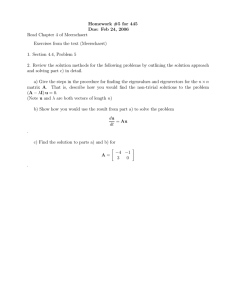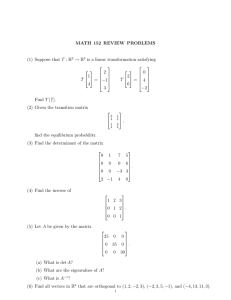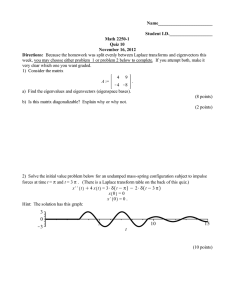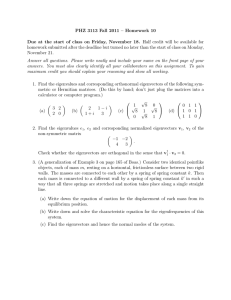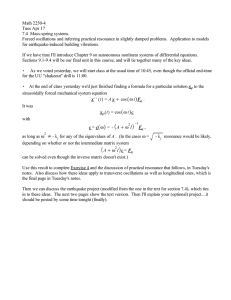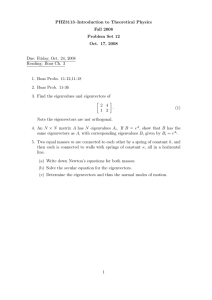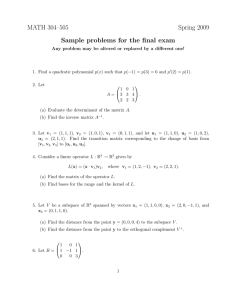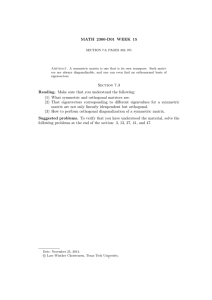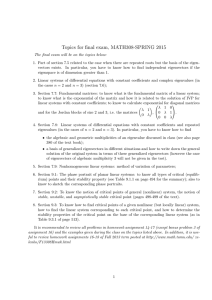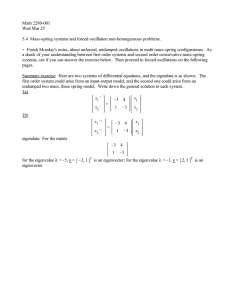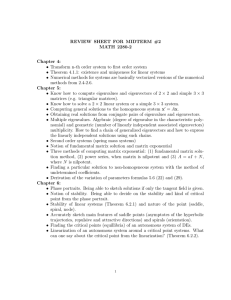Math 2250-1 Wed Nov 28
advertisement
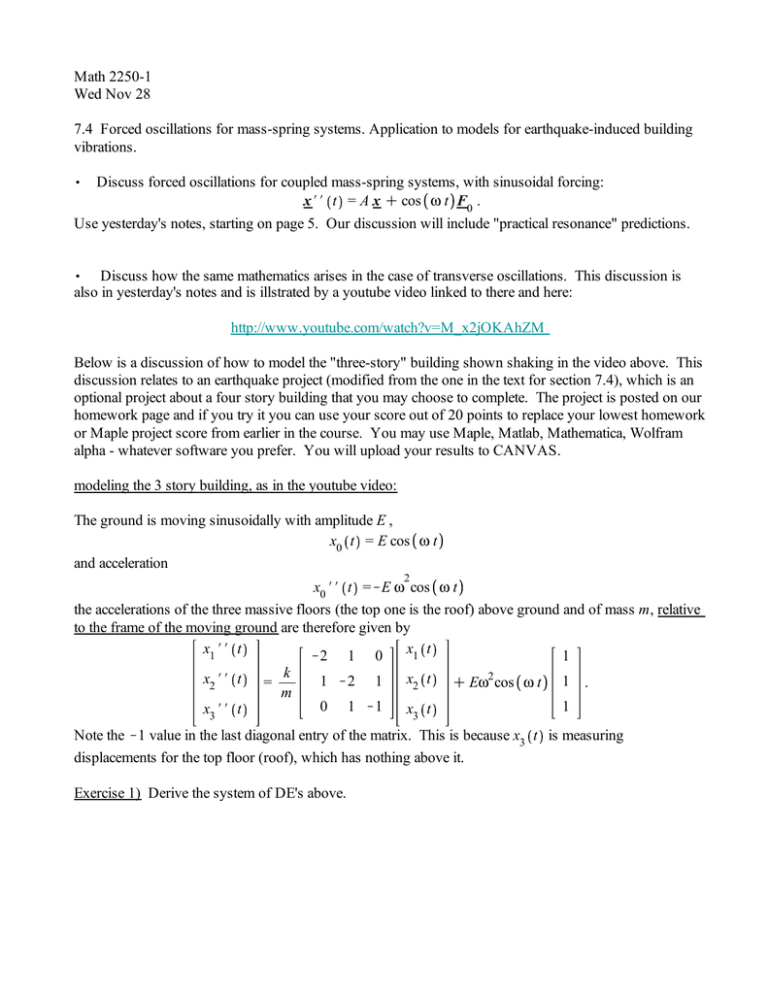
Math 2250-1 Wed Nov 28 7.4 Forced oscillations for mass-spring systems. Application to models for earthquake-induced building vibrations. Discuss forced oscillations for coupled mass-spring systems, with sinusoidal forcing: x## t = A x C cos w t F0 . Use yesterday's notes, starting on page 5. Our discussion will include "practical resonance" predictions. , , Discuss how the same mathematics arises in the case of transverse oscillations. This discussion is also in yesterday's notes and is illstrated by a youtube video linked to there and here: http://www.youtube.com/watch?v=M_x2jOKAhZM Below is a discussion of how to model the "three-story" building shown shaking in the video above. This discussion relates to an earthquake project (modified from the one in the text for section 7.4), which is an optional project about a four story building that you may choose to complete. The project is posted on our homework page and if you try it you can use your score out of 20 points to replace your lowest homework or Maple project score from earlier in the course. You may use Maple, Matlab, Mathematica, Wolfram alpha - whatever software you prefer. You will upload your results to CANVAS. modeling the 3 story building, as in the youtube video: The ground is moving sinusoidally with amplitude E , x0 t = E cos w t and acceleration 2 x0 ## t =KE w cos w t the accelerations of the three massive floors (the top one is the roof) above ground and of mass m, relative to the frame of the moving ground are therefore given by x1 ## t x1 t K2 1 0 1 x2 ## t x3 ## t = k m 1 x2 t 1 K1 x3 t 1 K2 0 C Ew2 cos w t 1 . 1 Note the K1 value in the last diagonal entry of the matrix. This is because x3 t is measuring displacements for the top floor (roof), which has nothing above it. Exercise 1) Derive the system of DE's above. k = 1 . For the scaled matrix you'd have the same m k eigenvectors, but the eigenvalues would all be multiplied by the scaling factor and the natural m k frequencies would all be scaled by . Symmetric matrices like ours (i.e matrix equals its transpose) m are always diagonalizable with real eigenvalues and eigenvectors...and you can choose the eigenvectors to be mutually perpendicular. This is called the "Spectral Theorem for symmetric matrices" and is an important fact in many math and science applications...you can read about it here: http://en.wikipedia. org/wiki/Symmetric_matrix.) If we tell Maple that our matrix is symmetric it will not confuse us with unsimplified numbers and vectors that may look complex rather than real. Here is eigendata for the unscaled matrix > with LinearAlgebra : > A d Matrix 3, 3, K2.0, 1, 0, 1,K2, 1, 0, 1,K1 ; # I used at least one decimal value so Maple would evaluate in floating point A := K2.0 1 0 1 K2 1 0 1 K1 (1) > Digits d 5 : # 5 digits should be fine, for our decimal approximations. > eigendata d Eigenvectors Matrix A, shape = symmetric : # to take advantage of the # spectral theorem lambdas d eigendata 1 : #eigenvalues evectors d eigendata 2 : #corresponding eigenvectors - for fundamental modes omegas d map sqrt,Klambdas ; # natural angular frequencies 2$evalf Pi f d x/ : x periods d map f, omegas ; #natural periods eigenvectors d map evalf, evectors ; # get digits down to 5 1.8019 omegas := 1.2470 0.44504 3.4870 periods := 5.0386 14.118 K0.59101 K0.73698 0.32799 eigenvectors := 0.73698 K0.32799 0.59101 K0.32799 0.59101 0.73698 > (2) Exercise 2) Interpret the data above, in terms of the natural modes for the shaking building . In the youtube video the first mode to appear is the slow and dangerous "sloshing mode", where all three floors oscillate in phase, with amplitude ratios 33 : 59 : 74 from the first to the third floor. What's the second mode that gets excited? The third mode? (They don't show the third mode in the video.) Exercise 3) Could you modify the matrix algebra, and then the commands in yesterday's notes, to create practical resonance graphs as we did there? Remark) All of the ideas we've discussed in section 7.4 also apply to molecular vibrations. The eigendata in these cases is related to the "spectrum" of light frequencies that correspond to the natural fundamental modes for molecular vibrations.
